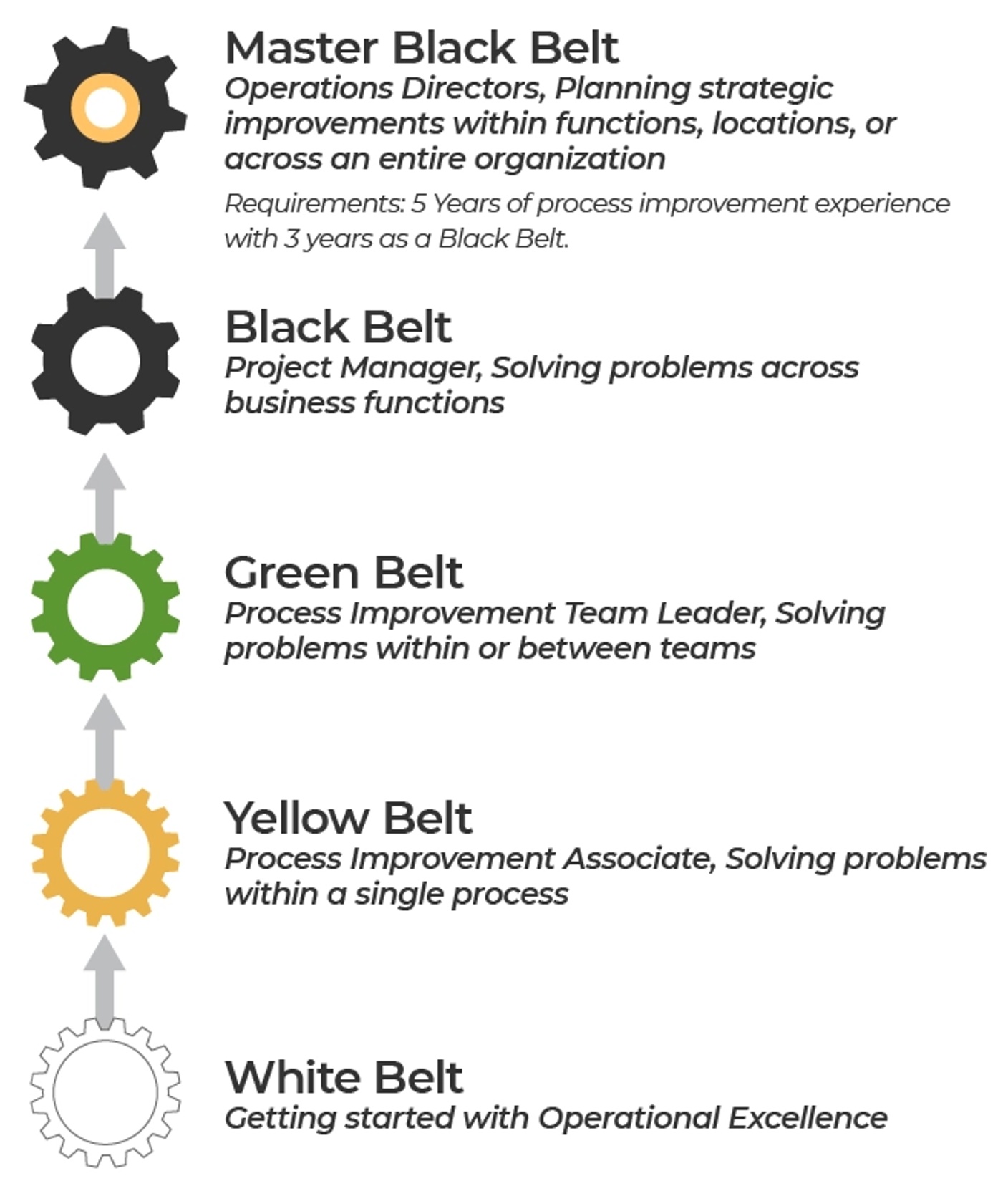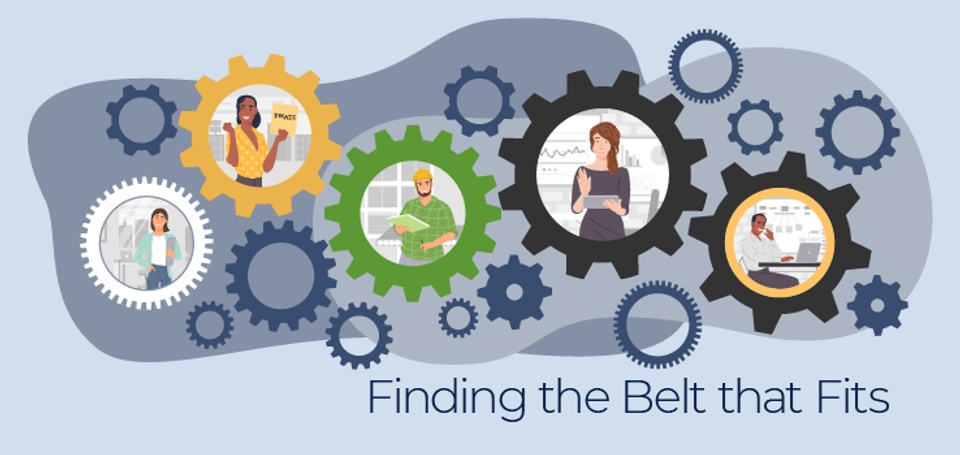
What is a Lean Six Sigma Black Belt?
A Lean Six Sigma Black Belt is an expert in process improvement, trained to lead and execute complex projects that drive measurable improvements in efficiency, quality, and cost reduction. Black Belts are masters of the DMAIC (Define, Measure, Analyze, Improve, Control) methodology and advanced data analysis techniques, enabling them to solve high-impact organizational problems. They play a pivotal role in identifying waste, streamlining operations, and ensuring sustainable improvements that align with strategic business goals.
Black Belts are not only technical problem solvers but also leaders and mentors. They guide teams, often coaching Green Belts, to achieve continuous improvement and foster a culture of operational excellence. Highly sought after across industries like manufacturing, healthcare, finance, and IT, Lean Six Sigma Black Belts are valued for their ability to transform processes, increase profitability, and enhance customer satisfaction, making them indispensable assets in competitive business environments.
Black Belt Quick Facts
Average Salary: Black Belts earn $137,645* annually, depending on industry and experience.
Cost Savings: Black Belts can save companies $300,000* or more per project by reducing waste.
Belt Level: A Black Belt is a high Six Sigma level, positioned above Green Belt and below Master Black Belt.
*As of 2024, reported in 'Salary by highest Six Sigma Belt—U.S. and Canadian respondents',' Quality Progress, December 2024.
Black Belts on the Job
What type of project work is expected from a Black Belt?
A Lean Six Sigma Black Belt spearheads complex improvement projects within an organization. Their role is pivotal in identifying critical areas for improvement and deploying Lean Six Sigma methodologies to drive change. Their projects often target significant organizational challenges, focusing on optimizing processes, reducing costs, and enhancing quality. Improvements in operational efficiency, customer satisfaction, and strategic outcomes are key metrics that Black Belt projects aim to achieve.
In addition to technical expertise, Lean Six Sigma Black Belts play a crucial role in change management and cross-functional collaboration. They are leaders in fostering a culture of operational excellence, mentoring Green Belts and other team members, and ensuring that initiatives are implemented across departments. By leveraging advanced analytical tools and methodologies, Lean Six Sigma Black Belts play a crucial role in driving substantial, sustainable improvements that align with the organization's strategic objectives.
Key Skills and Competencies of a Lean Six Sigma Black Belt
Lean Six Sigma Black Belts possess advanced skills and tools to lead complex improvement projects, mentor teams, and implement strategies that create measurable, long-term impacts. Their expertise goes beyond technical problem-solving; Black Belts play a critical role in aligning process improvements with organizational goals and fostering a culture of excellence.
Problem Solving
Addresses large-scale challenges by implementing data-driven, scalable solutions
Statistical Analysis
Uses tools like EngineRoom to analyze complex datasets and validate improvements
Mentorship
Guides Green Belts and teams through projects, ensuring alignment and success
Change Management
Navigates organizational resistance to implement process improvements
DMAIC Mastery
Leads projects through the Define, Measure, Analyze, Improve, and Control framework
Process Optimization
Identifies inefficiencies in workflows and develops solutions to streamline operations
Risk Assessment
Proactively identifies potential issues and designs processes to minimize risk and defects
Strategic Decisions
Aligns improvement initiatives with broader business objectives to maximize value
Industries and Career Paths for Black Belt
Lean Six Sigma Black Belt skills are applicable across diverse industries, from healthcare to technology. These roles enable professionals to drive quality, efficiency, and cost savings within their organizations.
- Healthcare: Black Belts lead high-impact projects to optimize patient care, streamline hospital workflows, and reduce operational costs while maintaining quality and safety standards.
- Finance: In finance, Black Belts tackle complex process inefficiencies, improve resource allocation, and implement strategies that enhance compliance, risk management, and client satisfaction.
- Manufacturing: Black Belts excel in minimizing waste, improving production quality, and implementing sustainable practices that boost productivity and reduce costs across the supply chain.
- Technology: In tech, Black Belts champion data-driven decision-making, optimize software development and operational workflows, and lead cross-functional teams in achieving innovation goals.
- Retail and Customer Service: Black Belts transform customer experiences by refining operational processes, ensuring service consistency, and driving loyalty through improved service quality.
What to Look for in a Lean Six Sigma Black Belt Course
Choosing the right Lean Six Sigma Black Belt course goes beyond cost, time commitment, or the credential itself. The real measure of a quality training program is in the lasting knowledge and confidence it builds in participants. Upon completing a Black Belt training program, participants should be able to lead complex improvement projects using the DMAIC methodology, analyze data to uncover root causes, develop strategic solutions, and implement sustainable changes through effective change management and team leadership.
Training Formats for Different Learning Styles
- Self-Paced Online: Ideal for independent learners, this format lets you progress at your own speed, exploring course materials and case studies at your convenience.
- Blended Learning: Enjoy the best of both worlds with a combination of self-paced study and live instruction, designed to deepen understanding and enhance skills.
What Does it mean to be Black Belt Certified?
Unlike some certifications, Black Belt certification standards are not universally set. At MoreSteam, certification requires not only passing a rigorous exam but also successfully completing two Black Belt projects that demonstrate your ability to apply Lean Six Sigma principles in a real-world scenario. Graduates receive a printed certificate and a digital badge to showcase their achievements.
Key Takeways for Black Belts
- Leadership Responsibilities: Black Belts lead high-impact projects, mentor Green Belts, and drive strategic improvements that align with organizational goals.
- Advanced Skills: Black Belts are experts in statistical analysis, process mapping, and change management in order to implement sustainable improvements.
- Industry-Wide Value: Black Belts are sought after in industries such as healthcare, manufacturing, finance, and IT for their ability to improve efficiency and quality.
- Career Advancement: Certification opens doors to leadership roles, higher earning potential, and opportunities to manage transformative projects.
- Strategic Confidence: MoreSteam training equips you with the tools and confidence to lead transformative changes and deliver measurable results.
Advance Your Career with MoreSteam's Black Belt Courses
At MoreSteam we offer several Black Belt courses, each built with the same high-impact and practice-based course content, just delivered to you differently based upon your unique learning needs. Select a course below to learn more and explore each Black Belt course further.
Want to Learn More About Lean Six Sigma? Curious About the Other Belt Levels?
Lean Six Sigma is a journey of continuous learning and growth, with each belt level offering unique skills and opportunities. If you're curious about how the Black Belt fits into the bigger picture or want to explore Lean Six Sigma in more detail, check out these resources:
What is Lean Six Sigma?: Discover the core principles of Lean Six Sigma and how it transforms organizations through continuous improvement.
Lean Six Sigma Belt Levels Explained: Discover how each level builds on the last and where the different belts fit into the continuous improvement process.
What is DMAIC Methodology?: Learn about the structured problem-solving process at the heart of Lean Six Sigma.
The History of Lean Six Sigma: An insightful interview exploring the origins and evolution of Lean Six Sigma.

Additional Resources for Lean Six Sigma Black Belt
Frequently Asked Questions
Still have questions? We're here to help.
614-602-8190
No Robots. Only humans.
support@moresteam.com
You'll still get a human here, too.




